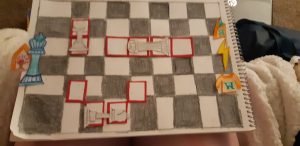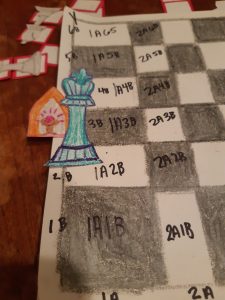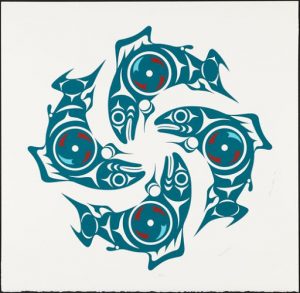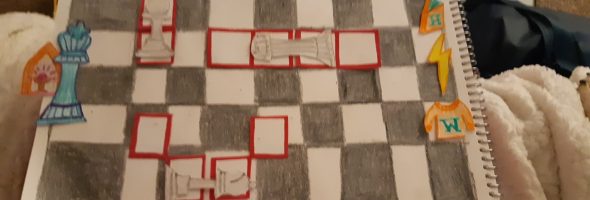Learning Object: Harry Potter and the Philosopher’s Stone Chess Game Model
Kathleen Wick & Lauren La Prairie


This learning object is designed for a Grade 6 class to aid them in understanding
combinations of transformations. The model we have created is a scaled replica of the giant
chess game from Rowling’s Harry Potter and the Philosopher’s Stone. When introducing this
learning object to students the teacher would pre-select a student that knows how to play chess
and ask them if they are willing to play a short and incomplete game of chess with you in front of
the class. Later, the teacher and student would model some of a chess game with this student in
front of the class using chess pieces with squares attached so that students have a visual
representation of how pieces move across the board. After this game, there would be a whole
class discussion on what they saw, what was happening to the pieces, and what other board
games they know that have similar properties. Further, if time and the majority of students know
how to play chess the class could break off into pairs and play games of chess. Alluding to the
model, it is a drawn chess board with moveable, drawn chess pieces. Attached to each chess
piece are squares that move with the piece to show the directions the piece can be moved in. This
is to help students visualize how to plot points on a chess board. This will (hopefully) later
translate into students’ understanding of how to plot points on a Cartesian Plane, making this
model educationally useful. Our chess board also features a border that shows the numbers
associated with each chess square. Again, this should help students identify coordinates on one
quadrant of a Cartesian Plane, which increases the educational utility of the model.This leads us
into a discussion on how this model connects to the curriculum.
The model would be used to introduce this idea, and in later lessons, students would
have the opportunity to create their own models and board games that model and use
combinations of transformations to practice and solidify their understanding of this concept. This
learning object can be used in Grade 6 and 7 as understanding combinations of transformations
(Curricular Content) and connecting math concepts to each other and to other areas and personal
interests (Curricular Competency) are part of the curriculum in both these grades. However, in
Mathematics Seven students are building off their knowledge of combinations of transformations
that they learned in Grade 6; therefore, the model and future lessons may need to be adjusted to
match the different expectations of this curriculum. However, the curricular competency
surrounding connecting math concepts to their personal life has the same expectations in both
grades, so aspects of the model that touch on this Curricular Competency can remain the same in
both. Moreover, this learning object connects to the Big Idea “linear relationships can be
identified and represented using expressions with variables and line graphs and can be used to
form generalizations”. This Big Idea is from the Grade 6 Mathematics curriculum. However, the
Grade 7 curriculum has a similar Big Idea “linear relationships can be represented in many
connected ways to identify regularities and make generalizations” that this learning object could
support. The Grade Six Curricular Competency, Content, and Big Idea connections will be
further discussed in the paragraph below as this is the audience the model was created for.
These curricular connections leads us into a deeper discussion about the Big Idea,
Curricular Competency, and Content that this model supports for the Grade Six Mathematics
curriculum. In regards to Content this interactive model checks the box for “combinations of
transformations” because it is an interactive model that helps students visualize what Cartesian
coordinates look like, as the chess board is a very good example of a quadrant on a Cartesian
Plane. It is important to note that the chess game only models one quadrant as this is the level of
understanding expected for a Grade Six class. However, if some students are ready, you could
stretch student understanding by asking them to create a model that highlights all four quadrants
in a Cartesian Plane. As mentioned in the previous paragraph, this model satisfies the Curricular
Competency “connect math concepts to each other and other areas of personal interest”. This
learning object helps students do this by showing them that combinations of transformations and
Cartesian Planes and coordinates are all used in aspects of daily life, like board games. The
connections to Rowling’s Harry Potter and The Philosopher’s Stone serves to pique student
interest and aid them into connecting math with different curricular areas. Last, this model helps
students work towards the Big Idea “linear relationships can be identified and represented using
expressions with variables and line graphs and can be used to form generalizations” because in
this model students can see how understanding linear relationships is key when playing
chess.This understanding produced by the model could be built upon in later lessons by playing a
game with coordinates that are expressions with variables and asking students to understand
where someone wants to move their chess piece based on this information.
Progressing towards inspiration, the idea for the model was inspired by Tim’s list of
possible ideas and our desire to bring other curricular areas into math to make it more accessible
and engaging for learners. Especially those learners who experienced math as something
removed from other subject areas with no connections to real-life and other curricular areas.
Furthermore, the moving chess pieces featured in our model are influenced by the moving chess
game from Rowling’s Harry Potter and The Philosopher’s Stone. While we have chosen to
create our model portraying this, students would be encouraged to create their own model, then
board game that models and uses combinations of transformations in future lessons. These
models and board games will be on a topic they feel they can incorporate combinations
transformations into but are also relevant to their real lives. Furthermore, students would also be
encouraged to incorporate ideas from other curricular areas like English Language Arts, Visual
Arts, or Social Studies.This is in an effort to increase cross-curricular units, as we are learning
this is best practice.
In accordance with best practice, because this model is being used to introduce the
concept of combinations of transformations we recommend that teachers use this learning object
as an opportunity to do formative assessment on how much prior, or newly formed knowledge
students have on this concept. Teachers would do this by listening to students questions,
comments, and reactions during the discussion and filling out a checklist to see who has the
foundational concepts and who does not. Because you will not likely hear all kids speak in the
discussion, find the students you have not heard from and ask them similar questions to the
discussion during the partnered chess games. If in the discussion students cannot make
connections between the game and the ideas surrounding combinations of transformations,
maybe the teacher needs to backpedal and find a new starting ground for this concept that is in
the Zone of Proximal Development for most students. If the students seem more advanced in
their knowledge than the unit you had planned, one would want to revamp their unit to meet this
need.
This model is a great way to incorporate the First People’s principles and mathematical
frameworks into your lesson on transformations and cartesian planes. Much of the coast salish
art that comes from the island relies on the use of mirrored images and rotations of like shapes.
Given the proliferation of coast salish art throughout Victoria and the school districts, each
student will be familiar with the symmetry and systematic orientation of like shapes around a set
plane. If your aim is to create a cross-curricular lesson around math, art and social studies, this
topic and learning object is an excellent jumping off point. At some point in your lesson have
students look through various artworks by local artists that embody the concept of
transformation. We have provided an example below.


